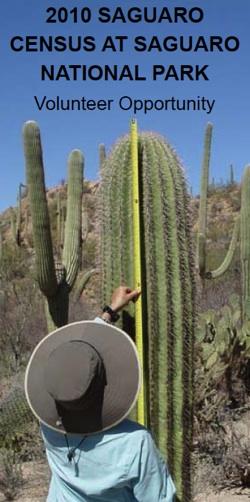Much as the bison is to Yellowstone National Park, the saguaro cactus is to Saguaro National Park. Tall, spiny, and handsome, the noble saguaro was the impetus behind the creation of Saguaro National Park, and reigns today as that park's icon. With hopes of ensuring it stays that way, every decade Saguaro officials launch a "Saguaro Census" to track the health of this cacti population. And if you don't mind heat or walking, you're invited to help out.
Saguaro National Park was established in 1933 to protect the famous stand of “giant” saguaros at the base of the Rincon Mountains east of Tucson. From the beginning, people were concerned that this stand was dying out, according to the Park Service. Monitoring of saguaros at the park began in 1942 and, thanks to dedicated researchers, has continued every year since, the agency adds. This research indicates that the old giants are continuing to die. However, new saguaros began to appear in large numbers in the early 1970s. The saguaro forest is slowly being replaced by these slow-growing youngsters.
The current census started in the fall and continues through March, giving you plenty of opportunities to contribute your time and counting abilities to the cause.
"We are seeking volunteer groups to help with the 2010 census," proclaims the park on a web page devoted to the census. "The ideal group consists of 10-15 people, but we are flexible. However, all volunteers must be very 'desert hardy' – that is, fit and able to work on rocky slopes, in the sun, for approximately 6 hours. Volunteers do not need be experienced, but must be interested in science and love the outdoors. We will train you to measure saguaros using measuring sticks, clinometers, and high school math! To sign up or get more information, call Don Swann, Saguaro National Park Biologist, at 520-733-5177."
The duties of cacti counters are few. You need to be able to hike to saguaro monitoring plots in the desert backcountry, identify, measure, and count saguaros, and record scientific data accurately.
The last census that took place in 2000 revealed that there has been an increase in Saguaro recruitment from the previous census in 1990. In the park's Tuscon Mountain District, aka "Saguaro West," the 1990 census raised a tally of 789,245 saguaros, according to the park, while in 2000 that number had jumped to 1,091,181. In the Rincon Mountain District, aka "Saguaro East," the tallies were 190,000 saguaros in 1990 and 243,375 a decade later.




Comments
I wish I could be there: it should be beautiful, the folks leading this project know a ton about the desert and saguaros, and this saguaro monitoring is part of over 100 years of saguaro demography dating back to Forrest Shreve.
If you want more background, there's a technical report in the NPS Natural Resource Report Series NPS/SODN/NRR--2009/093:
Ahnmark & Swann. 2009. A history of saguaro cactus monitoring in Saguaro National Park
Relevant to the recent posts about abolishing NPS units, Joe McAuliffe wrote a wonderful report in 1993, reviewing and criticizing the previous decades of research & monitoring & management. Saguaros were thought to be dying from bacterial necrosis, from air pollution, from lack of recruitment of new plants. The NPS regional director recommended abolishing SAGU in 1945 because the saguaros would soon all be dead. The uncertainty about SAGU's future persisted until the 1960s, so SAGU had low priority for funding and resources. One big problem was that several important studies were performed by the lowest bidder with no technical review of the methodology, and thus produced worthless or even misleading "results". Massive aerial DDT spraying was proposed to kill the moth that was thought to be spreading the bacterial disease, as was large-scale transplantation of nursery-raised juvenile saguaros for "reforestation"; fortunately neither was implemented.
McAuliffe 1993. Case study of research, monitoring, and mamagement programs associated with saguaro cactus (Carnegiea gigantea) at Saguaro National Monument, Arizona